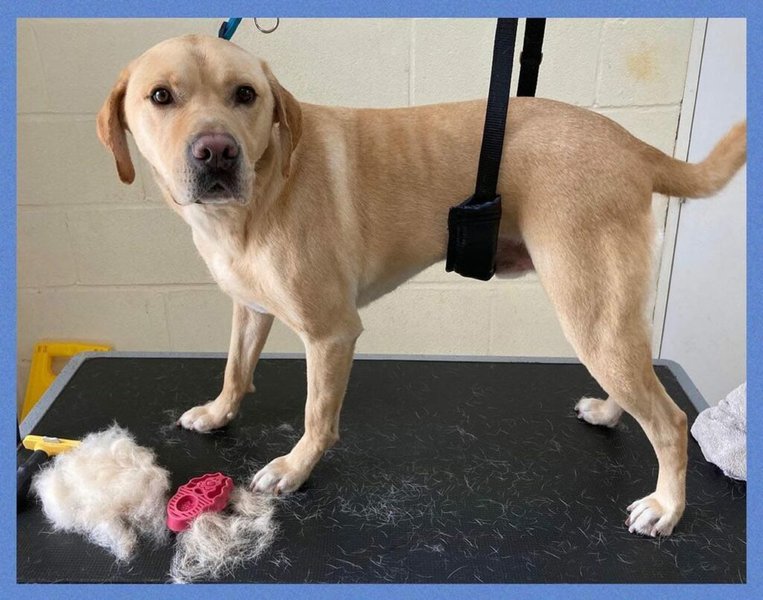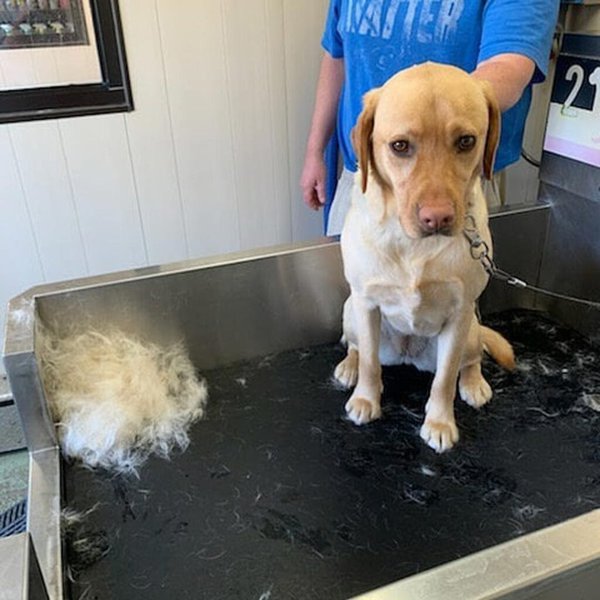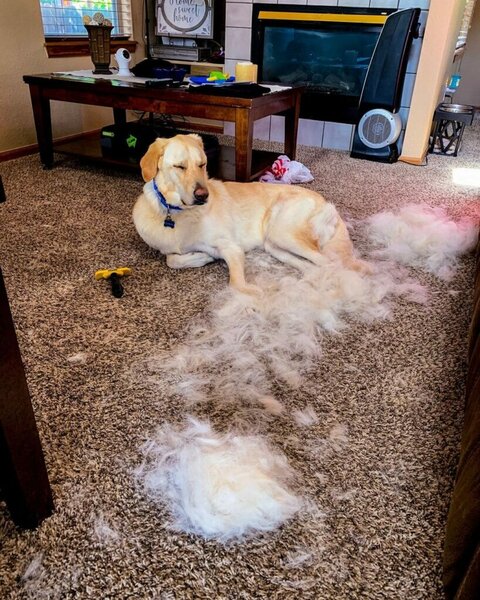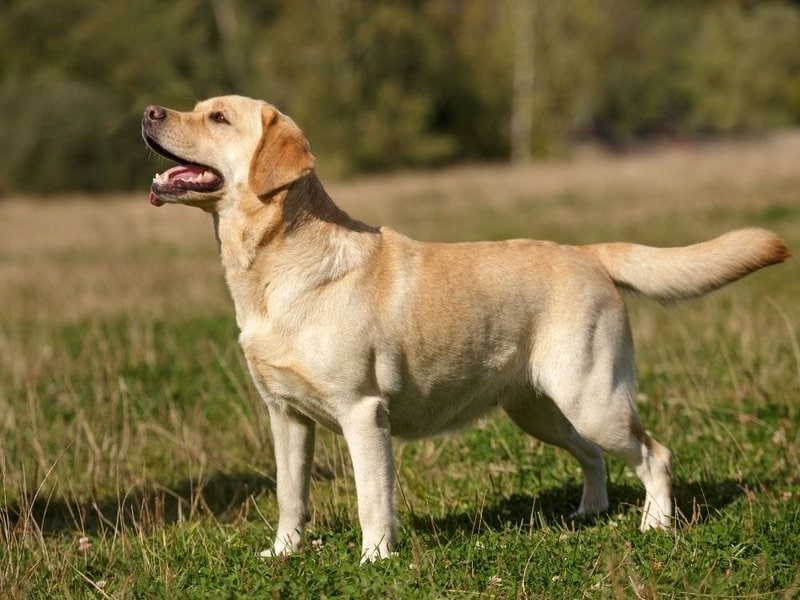The Labrador is known for its warm affable nature which makes it the most popular dog breed in America. However, before you bring one of these fur babies home, it is important to know just how much dog hair you will have to deal with.
So, do Labradors shed? Yes, Labradors shed quite heavily. Labrador Retrievers shed a lot because like other working breeds, they have a double coat to keep them insulated from the elements. Shedding will happen to both the inner and outer coats of the Labrador. The inner coat typically sheds completely twice a year while the outer coat sheds seasonally. During molting, when the inner coat is being shed, is when the hair fall is at its peak.
Labs are adorable, loyal pups that make great family pets. However, dog hair can be a pesky problem for pet parents. So is there anything you can do to control the shedding? Let’s take a look at everything you need to know about molting and your Labrador.
Will My Lab Ever Stop Shedding?
The adorable silky coat of the Lab is incredibly dense which means that these pups shed all year round. Breeds with double coats typically shed a lot more because they have a lot more hair.
Shedding Frequency
A Labrador loses or blows its coat twice a year. This is known as the molting period and it is during this season that the heaviest shedding occurs.
Molting occurs in springtime when Labs shed their dense inner coat to prepare for the warm summer months. In the winter, shedding occurs as the Labradors produce a new coat to keep it warm in the colder months.
Apart from the two main shedding seasons, the Labrador also sheds its outer coat year-round. However, the heaviest shedding occurs during the molting season.
Shedding Triggers
Any Lab parent will tell you that dealing with dog hair is a natural part of the job. However, there are some triggers that may cause a lab to shed excessively. These include:
- Fleas – a flea infestation may cause your Labrador to shed more than usual
- Allergies – if your Lab has allergies they may shed excessively
- Skin conditions – some skin conditions may cause your Labrador to shed more than usual
- Mites and parasites – parasitic infections and mites may cause excessive shedding
- Stress – anxiety or stress has been found to increase shedding in dogs
When is Shedding too Much?
Labradors are heavy shedders and they will lose hair all year round. However, there are some cases when your lab’s shedding may be due to other conditions. Consult your vet if you observe any of the following conditions.
- Bald patches – if your Labrador starts to develop bald patches, that could be due to a skin condition and not necessarily as a result of normal shedding.
- Inflamed skin – inflammation on the skin is also a sign that your dog may need to see a vet as they may have an underlying condition.

What Months Do Labs Shed The Most?
If you are looking for a loyal and affectionate family pet, the charming Labrador rarely falls short. However, there will be months when your Labrador sheds a lot and you need to be prepared for it.
Springtime
Working dog breeds like Labradors have double coats. This means that they have an inner and outer coat to protect them from the elements.
As the warmer months approach, your pup does not need as much insulation so they start to shed the inner coat. This is referred to as molting and it usually occurs in the springtime just before the hot summer months.
Molting season will usually last approximately three weeks. This is the period when your Labs will shed the most.
Winter
During winter your Labrador needs more insulation from the cold. To achieve this, your pooch will shed the sparse summer coat so that they can grow a denser coat for the winter months.
This results in the shedding of the old coat to make room for the new one. This means that you should expect your Labrador to shed during winter.
All-Year-Round
The major shedding in Labrador occurs twice a year, but this breed will shed all year round. However, the shedding is usually much lighter outside of the molting season. You will also notice that your Labrador sheds more as they age. This is completely natural.
You should also expect your Labrador puppy to lose their puppy coats at the age of 4 or 5 months. At this age, your pup will shed their coat and grow a longer coat.

How Can I Stop My Labrador From Shedding?
Dog hair can be a pesky problem for pet parents. While you may not be able to stop your Labrador from shedding altogether, there are a few things you can do to make the shedding more bearable.
Grooming
Brushing your Labradors coat daily is important in helping to minimize shedding.
When you brush the coat, you can easily get rid of loose hairs which may otherwise end up on your furniture. It is important to brush your Labrador at least once a day to keep shedding to a minimum.
Get a tool like the Furminator Deshedding Tool that is specifically designed to minimize shedding. The Furminator helps to remove loose hair from both the outer and inner coat getting rid of any loose hairs.
Regular Baths
Regular baths are essential in keeping your Labradors coat clean and healthy. Skin infections can exacerbate shedding and make it worse. Bathing your Lab at least once a month is ideal.
If your pup is particularly active, you can bathe them as needed. A clean healthy coat will reduce the risk of skin infections that cause excessive shedding.
You should never shave your Labradors coat in an attempt to minimize shedding. Your Lab needs their heavy coat for insulation and protection from the elements. Cutting a Lab’s hair may cause health complications and is not recommended.
Get A Pet-Friendly Vacuum
Investing in a good vacuum will help you clean up after your Labrador a lot faster. There are vacuums that are made specifically to clean up pet allergens and dog hair. This type of vacuum will help you keep your home relatively free of dog hair.
Ultimately having a Labrador means that you will have to deal with shedding. However, with good grooming and a healthy diet, you can keep the shedding at manageable levels.

What Dog Food Helps With Shedding?
A healthy diet means a healthy coat. This means that when it comes to managing your Lab’s shedding you cannot overlook the role of a healthy diet.
Nutrient-Rich Diet
A diet rich in proteins, as well as essential minerals and vitamins, is extremely important if you want to keep your Labrador’s coat healthy. Go for nutrient-rich foods enriched with essential fatty acids and vitamin E which make your pup’s coat healthy and less prone to shedding.
A poor diet is also more likely to lead to skin allergies. It is best to avoid dog foods with filler content such as soy and corn. These fillers tend to be common allergens that can cause your lab to shed more than usual.
Coconut Oil
Coconut oil is a healthy and effective way to reduce shedding. Coconut oil contains medium chain triglycerides (MCT) which help to boost skin health. MCT also helps in healing dry and brittle hair which is more prone to shedding.
You can apply coconut oil topically to your dog’s coat or add a teaspoon to their meals to boost skin health. It is best to use virgin coconut oil since it is the healthiest option.
Fish Oil
Fish oil can help in reducing shedding in Labs. This is because the essential fatty acids in fish oil are essential in keeping your Lab’s coat healthy. Fish oil can also help in relieving dry skin and inflammation which may often cause your Lab to shed excessively.
Nutrient-dense formulas like the Zesty Paws Pure Wild Alaskan Salmon Fish Oil are ideal for high shedding dog breeds like the Labrador. Zesty Paws is rich in essential fatty acids which help to keep your dog’s coat healthy.
While fish oil is generally well-tolerated in dogs, it is best to consult your vet for the appropriate dosage. Too much fish oil can and may cause adverse side effects.
Related Questions
What Breed Of Large Dog Sheds The Least? The Standard Poodle is a large dog breed that sheds minimally. Poodles have a single coat of curly hair. This breed is classified as a hypoallergenic breed because it is one of the lowest shedding dog breeds. Poodles are a good option for people with allergies since they shed very little.
Do English Labs Shed More Than American Labs? English Labs shed just as much as American Labs. Both English Labs and American Labs have a dense double coat. Both of these Labs, therefore, tend to shed at more or less the same rate. To minimize shedding in Labradors, daily brushing is recommended.
Are There Any Labs That Don’t Shed? All Labs shed. This is largely due to their double coat. The Labrador is a working dog breed that comes with a dense double coat. The double coat helps to keep working breeds like Labs well insulated and protected from the elements. Shedding in Labrador is a natural process that can be managed but not prevented.





